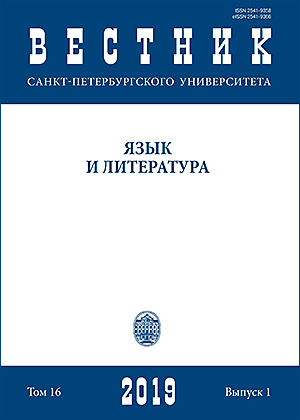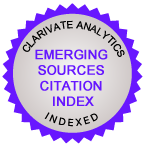French weekly journals “Charlie Hebdo” and “Le Canard Enchaîné”: linguistic means of creating a comic, thematic field and target audience
DOI:
https://doi.org/10.21638/spbu09.2019.101Abstract
The satirical press has a long history and established traditions in France, being an integral part of French culture. Understanding this phenomenon leads to a clear understanding of the mechanisms of the emergence and functioning of satire as such and the clarification of its role in French society. A considerable amount of research has been devoted to the French satirical press, but questions related to the linguistic means of representing the comic are still poorly studied. The aim of this work is an attempt to present lexical and stylistic means of creating a comic effect, with the example of two weekly journals — Charlie Hebdo and Le Canard Enchaîné. In addition, we try to answer the question of whom (the social portrait of the reader) and what the modern French satirical press is making laugh at (the thematic spectrum). The research was realised under several approaches to text analysis: functional pragmatic; lexico-semantic approach; stylistic and socio-cultural. The source of the research is a compilation of the newspapers Charlie Hebdo and Le Canard Enchaîné for the period from 2009 to 2016. In addition, two interviews conducted by the author in Paris with journalists of Canard Enchaîné and Charlie Hebdo were used to understand the current concept of publications, including language policy (language presentation of the style). Finally, a survey of the social portrait of readers was conducted in France using the questionnaire method. As a result, 128 French respondents were interviewed.
Keywords:
Charlie Hebdo, Le Canard Enchaîné, French satirical press, comic, irony
Downloads
References
Литература
Голосова 2016 — Голосова Н. В. Прагмалингвистические основания комического. Филологические науки. Вопросы теории и практики. 2016, 60 (6)-3: 81–83.
Дмитриев 1996 — Дмитриев А. В. Социология юмора: Очерки. М.: РАН, 1996. 214 c.
Калинина 2016 — Калинина Е. Э. Языковая игра как средство проявления комического. Вестник педагогического опыта. 2016, 37: 21–23.
Капацинская 2007 — Капацинская В. М. Комический текст. Проблема выделения речевого и ситуативного комического в тексте. Вестник Нижегородского университета им. Н. И. Лобачевского. 2007, 3: 224–228.
Карасик 2017 — Карасик В. И. Аксиогенные комические личные нарративы. Жанры речи. 2017, 2: 203–209.
Середа, Граббе 2016 — Середа П. В., Граббе Н. Ю. Комическое в контексте различных типов дискурса. Научные труды КубГТУ. 2016, 1: 117–125.
Середина 2017 — Середина Е. В. Ирония в политической карикатуре. Современные тенденции развития науки и технологий. 2017, 3–6: 66–70.
Суровегина 2016 — Суровегина Д. И. Концепт смеха в прагмалингвистике (к вопросу о речевой комической ситуации). Вестник МГУ. Серия 19. Лингвистика и межкультурная коммуникация. 2016, 3: 62–69.
Фарран 2017 — Фарран Е. О. К вопросу о комическом. В кн.: Современные тенденции в преподавании русского языка и литературы. Материалы докладов и сообщений XXII Международной научно-практической конференции. Свидинская Н. Т. (ред.). СПб.: СПбГУПТД, 2017. С. 202–205.
Фененко 2005 — Фененко Н. А. Комическое в тексте оригинала и перевода. Вестник ВГУ. Серия «Лингвистика и межкультурная коммуникация». 2005, 2: 97–104.
Akimoto, Miyazawa 2017 — Akimoto Y., Miyazawa S. Individual differences in irony use depend on context. Journal of Language and Social Psychology. 2017, 36 (6): 675–693.
Aristova 2014 — Aristova V. “Notre premier sujet c’est la politique”: Charlie Hebdo and Contemporary French Politics. French Studies Bulletin. 2014, 35 (133): 85–88.
Atayan, Wienen 2010 — Atayan V., Wienen U. Ironie et un peu plus. Frankfurt am Main: Peter Lang, 2010. Bd. 2. 284 s.
Burgers, Renardel de Lavalette, Steen 2018 — Burgers C., Renardel de Lavalette K. Y., Steen G. J. Metaphor, hyperbole, and irony: Uses in isolation and in combination in written discourse. Journal of Pragmatics. 2018, 127: 71–83.
Cavanna 1981 — Cavanna F. Bête et méchant. Paris: P. Leblond, 1981. 302 p.
Dynel 2016 — Dynel M. Comparing and combining covert and overt untruthfulness: On lying, deception, irony and metaphor. Pragmatics and Cognition. 2016, 23 (1): 174–208.
Fabrice 2007 — Fabrice E. L’arme du rire: la presse satirique en France 1789–1848. Thèse de doctorat en histoire. Paris, Sorbonne 1, 2007. 740 p.
Fontenelle 2010 — Fontenelle S. Même pas drôle: Philippe Val, de Charlie Hebdo» à Sarkozy. Paris: Libertalia, impr., 2010. 172 p.
Gurillo, García 2009 — Gurillo R., García P. Dime cómo ironizas y te diré quién eres Una aproximación pragmática a la ironía. Frankfurt: Peter Lang, 2009. 483 p. (На исп. яз.)
Haverkate 1990 — Haverkate H. A speech act analysis of irony. Journal of Pragmatics. 1990, 14: 77–109.
Hong 2011 — Hong Z. A relevance-theoretic approach to verbal irony: A case study of ironic utterances in Pride and Prejudice. Journal of Pragmatics. 2011, 43 (1): 175–182.
Kamyanets 2017 — Kamyanets A. Translating irony in media texts: A relevance theory perspective. Across Languages and Cultures. 2017, 18 (2): 261–278.
Kerbrat-Orecchioni 1978 — Kerbrat-Orecchioni С. Problème de l’ironie. In: Kerbrat-Orecchioni C. (ed.). L’ironie. Linguistique et sémiologie. Lyon: PUL, 1978. P. 9–46.
Kerbat-Orecchioni 1980 — Kerbat-Orecchioni С. L’ironie comme trope. Poétique. 1980, 41: 109–128.
Laurent 1996 — Laurent P. L’Ironie mise en trope. Du sens des énoncés hyperboliques et ironique. Paris: Ed. Kimé, 1996. 236 p.
Martin 2005 — Martin L. Le Canard Enchaîné: histoire d’un journal satirique. Paris: Nouveau Monde éd., 2005. 767 p.
Mazurier 2009 — Mazurier S. Bête et méchant hebdomadaire: une histoire de Charlie Hebdo. Paris: Buchet Chastel, impr., 2009. 511 p.
Reyes 2005 — Reyes G. La ironia verbal y su enfoque pragmático. Fundamentos teóricos. VII Jornadas de Estudios de Lingüistica, Universidad de Alicante. 2005: 1–11. (На исп. яз.)
Strilets-Zapotitchna 2015 — Strilets-Zapotitchna N. Y. Particularités de contsruction et fonctions stylistiques du calembour dans la presse satirique française (étude basée sur l’homonymie). Науковий вісник Міжнародного гуманітарного університету. Сер.: Філологія. 2015, 15–2: 142–145.
Tamagne 2003 — Tamagne F. Caricatures homophobes et stéréotypes de genre en France et en allemagne: la presse satirique, de 1900 au milieu des années 1930. Nouveau Monde éditions “Le Temps des médias”. 2003, 1: 42–53
References
Голосова 2016 — Golosova N. V. [Pragmalinguistic basis of comic]. Filologicheskie nauki. Voprosy teorii i praktiki. 2016, 60 (6)-3: 81–83. (In Russian)
Дмитриев 1996 — Dmitriev A. V. Sotsiologiia iumora: Ocherki. [Sociology of Humor: Essays]. Moscow: Without publishing, 1996. 214 p. (In Russian)
Калинина 2016 — Kalinina E. E. [Language game as a means of manifesting the comic]. Vestnik pedagogicheskogo opyta. 2016, 37: 21–23. (In Russian)
Капацинская 2007 — Kapatsinskaia V. M. [Comic text. The problem of singling out the speech and situational comic in the text]”. Vestnik Nizhegorodskogo universiteta im. N. I. Lobachevskogo. 2007, 3: 224–
(In Russian) Карасик 2017 — Karasik V. I. [Axiogenic comic personal narratives]. Zhanry rechi. 2017, 2: 203–209. (In Russian) Середа, Граббе 2016 — Sereda P. V., Grabbe N. Iu. [Comic in the context of various types of discourse]. Nauchnye trudy KubGTU. 2016, 1: 117–125. (In Russian) Середина 2017 — Seredina E. V. [The irony in the political caricature]. Sovremennye tendentsii razvitiia nauki i tekhnologii. 2017, 3–6: 66–70. (In Russian)
Суровегина 2016 — Surovegina D. I. [The concept of laughter in pragmalinguistics (towards the question of the speech comic situation)]. Vestnik MGU. Seriia 19. Lingvistika i mezhkul’turnaia kommunikatsiia. 2016, 3: 62–69. (In Russian)
Фарран 2017 — Farran E. O. [Towards the question of the comic]. Sovremennye tendentsii v prepodavanii russkogo iazyka i literatury. Materialy dokladov i soobshchenii XXII Mezhdunarodnoi nauchno-prakticheskoi konferentsii. Svidinskaya N. T. (ed.). St. Petersburg: St. Petersburg State University of Industrial Technology and Design Press, 2017. P. 202–205. (In Russian)
Фененко 2005 — Fenenko N. A. [Comic in the text of the original and translation]. Vestnik Vestnik VGU. Seriia «Lingvistika i mezhkul’turnaia kommunikatsiia». 2005, 2: 97–104. (In Russian)
Akimoto, Miyazawa 2017 — Akimoto Y., Miyazawa S. Individual differences in irony use depend on context. Journal of Language and Social Psychology. 2017, 36 (6): 675–693.
Aristova 2014 — Aristova V. “Notre premier sujet c’est la politique”: Charlie Hebdo and Contemporary French Politics. French Studies Bulletin. 2014, 35 (133): 85–88.
Atayan, Wienen 2010 — Atayan V., Wienen U. Ironie et un peu plus. Frankfurt am Main: Peter Lang, 2010. Bd. 2. 284 p.
Burgers, Renardel de Lavalette, Steen 2018 — Burgers C., Renardel de Lavalette K. Y., Steen G. J. Metaphor, hyperbole, and irony: Uses in isolation and in combination in written discourse. Journal of Pragmatics. 2018, 127: 71–83.
Cavanna 1981 — Cavanna F. Bête et méchant. Paris: P. Leblond, 1981. 302 p.
Dynel 2016 — Dynel M. Comparing and combining covert and overt untruthfulness: On lying, deception, irony and metaphor. Pragmatics and Cognition. 2016, 23 (1): 174–208.
Fabrice 2007 — Fabrice E. L’arme du rire: la presse satirique en France 1789–1848. Thèse de doctorat en histoire. Paris, Sorbonne 1. 2007. 740 p.
Fontenelle 2010 — Fontenelle S. Même pas drôle: Philippe Val, de Charlie Hebdo» à Sarkozy. Paris: Libertalia, impr., 2010. 172 p.
Gurillo, García 2009 — Gurillo R., García P. Dime cómo ironizas y te diré quién eres Una aproximación pragmática a la ironía. Frankfurt: Peter Lang, 2009. 483 p.
Haverkate 1990 — Haverkate H. A speech act analysis of irony. Journal of Pragmatics. 1990, 14: 77–109.
Hong 2011 — Hong Z. A relevance-theoretic approach to verbal irony: A case study of ironic utterances in Pride and Prejudice. Journal of Pragmatics. 2011, 43 (1): 175–182.
Kamyanets 2017 — Kamyanets A. Translating irony in media texts: A relevance theory perspective. Across Languages and Cultures. 2017, 18 (2): 261–278.
Kerbrat-Orecchioni 1978 — Kerbrat-Orecchioni С. Problème de l’ironie. In: Kerbrat-Orecchioni C. (ed.) L’ironie. Linguistique et sémiologie. Lyon: PUL, 1978. P. 9–46.
Kerbat-Orecchioni 1980 — Kerbat-Orecchioni С. L’ironie comme trope Poétique. 1980, 41: 109–128.
Laurent 1996 — Laurent P. L’Ironie mise en trope. Du sens des énoncés hyperboliques et ironique. Paris: Ed.
Kimé, 1996. 236 p. Martin 2005 — Martin L. Le Canard Enchaîné: histoire d’un journal satirique. Paris: Nouveau Monde éd., 2005. 767 p.
Mazurier 2009 — Mazurier S. Bête et méchant hebdomadaire: une histoire de Charlie Hebdo. Paris: Buchet Chastel, impr., 2009. 511 p.
Reyes 2005 — Reyes G. La ironia verbal y su enfoque pragmático. Fundamentos teóricos. VII Jornadas de Estudios de Lingüistica, Universidad de Alicante. 2005: 1–11.
Strilets-Zapotitchna 2015 — Strilets-Zapotitchna N. Y. Particularités de contsruction et fonctions stylistiques du calembour dans la presse satirique française (étude basée sur l’homonymie). Naukovii vіsnik Mіzhnarodnogo gumanіtarnogo unіversitetu. Ser.: Fіlologіya. 2015, 15–2: 142–145.
Tamagne 2003 — Tamagne F. Caricatures homophobes et stéréotypes de genre en France et en allemagne : la presse satirique, de 1900 au milieu des années 1930. Nouveau Monde éditions “Le Temps des médias”. 2003, 1: 42–53.
Downloads
Published
How to Cite
Issue
Section
License
Articles of "Vestnik of Saint Petersburg University. Language and Literature" are open access distributed under the terms of the License Agreement with Saint Petersburg State University, which permits to the authors unrestricted distribution and self-archiving free of charge.






